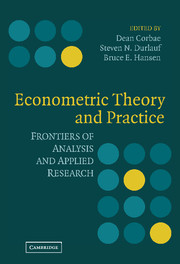Book contents
- Frontmatter
- Contents
- Preface: In Praise of a Remarkable Teacher
- Contributors
- Introduction
- PART I HIGHER-ORDER ASYMPTOTICS
- PART II IV SPECIFICATION TESTS
- PART III NONSTATIONARITY
- 6 Extracting Cycles from Nonstationary Data
- 7 Nonstationary Nonlinearity: An Outlook for New Opportunities
- 8 Multiple Structural Change Models: A Simulation Analysis
- PART IV LAD AND QUANTILE REGRESSION
- PART V NONSTATIONARY PANELS
- Index
6 - Extracting Cycles from Nonstationary Data
Published online by Cambridge University Press: 05 June 2012
- Frontmatter
- Contents
- Preface: In Praise of a Remarkable Teacher
- Contributors
- Introduction
- PART I HIGHER-ORDER ASYMPTOTICS
- PART II IV SPECIFICATION TESTS
- PART III NONSTATIONARITY
- 6 Extracting Cycles from Nonstationary Data
- 7 Nonstationary Nonlinearity: An Outlook for New Opportunities
- 8 Multiple Structural Change Models: A Simulation Analysis
- PART IV LAD AND QUANTILE REGRESSION
- PART V NONSTATIONARY PANELS
- Index
Summary
INTRODUCTION
At least since Burns and Mitchell (1946), economists have been interested in developing methods for extracting “business cycle” components from the level of a time series. One important practical issue, for example, is how to extract the cyclical component from real gross domestic product (GDP). Modern approaches to this problem include removal of polynomial functions of time, first differencing, and applying the Hodrick–Prescott (1980) filter, among others. Given the proliferation of these time-domain techniques to extracting the cyclical component, one might want to know which approach, if any, is optimal. If one accepts Burns and Mitchell's definition that the business cycle is fluctuations of real GDP with a specific periodicity (between 6 and 32 quarters), the answer is relatively clear using frequency-domain techniques. The problem arises in trying to map this approach back to the time domain. In particular, the exact bandpass filter is a moving average of infinite order in the time domain. For this reason, Baxter and King (1999), as well as Christiano and Fitzgerald (1999), construct a time-domain approximation to the exact filter that satisfies a particular set of criteria.
Here we wish to avoid the “time-domain” approximation error by approaching the problem in the frequency domain. One of the important drawbacks to frequency-domain filtering, noted by Baxter and King (1999, p. 580), is that, because most economic time series are likely to have nonstationary components, it is necessary to filter the series before taking its Fourier transform.
- Type
- Chapter
- Information
- Econometric Theory and PracticeFrontiers of Analysis and Applied Research, pp. 167 - 177Publisher: Cambridge University PressPrint publication year: 2006
- 34
- Cited by



